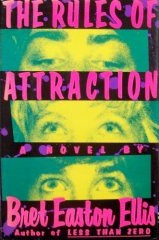Sean Bateman

Book cover for The Rules of Attraction
|
|
| Author | Bret Easton Ellis |
|---|---|
| Language | English |
| Genre |
Black comedy Satire |
| Publisher | Simon & Schuster |
|
Publication date
|
September 1987 |
| Media type | Print (Hardcover and Paperback) |
| Pages | 283 pp hardcover, 288 pp paperback |
| ISBN | |
| OCLC | 16082603 |
| 813/.54 19 | |
| LC Class | PS3555.L5937 R8 1987 |
The Rules of Attraction is a satirical black comedy novel by Bret Easton Ellis published in 1987. The novel focuses on a handful of rowdy and often sexually promiscuous, spoiled bohemian college students at a liberal arts college in 1980s New Hampshire, primarily focusing on three of them who find themselves in a love triangle. The novel is written in first person narrative, and the story is told from the points of view of various characters.
The book was adapted into a film of the same name in 2002. Ellis himself has remarked that of all the film adaptations of his books, The Rules of Attraction came closest to capturing his sensibility and recreating the world he created in his novels.
The novel is written in the first-person, continuing the aesthetic of Ellis' earlier Less Than Zero, and is told from the points of view of multiple characters. The main narrators are three students: Paul, Sean, and Lauren. A number of other characters also provide first-hand accounts throughout the story, which takes place at the fictional Camden College, a liberal arts school on the East Coast of the United States. The three main characters (who rarely attend class) end up in a love triangle within a sequence of drug runs, "Dress to Get Screwed," and "End of the World" parties.
The story begins midway through a sentence (the first word being 'and') in order to give the effect that it begins somewhere closer to the middle, rather than at a true beginning (in medias res). Another interpretation is that the story has neither a beginning nor an ending, signifying the endless cycle of in which the characters of the novel engage. This is sometimes mistaken by readers as a typographical error or the result of a missing page, but was purposely written by Ellis. The novel ends in a similar fashion, with the last sentence cut off before its end.
...
Wikipedia
